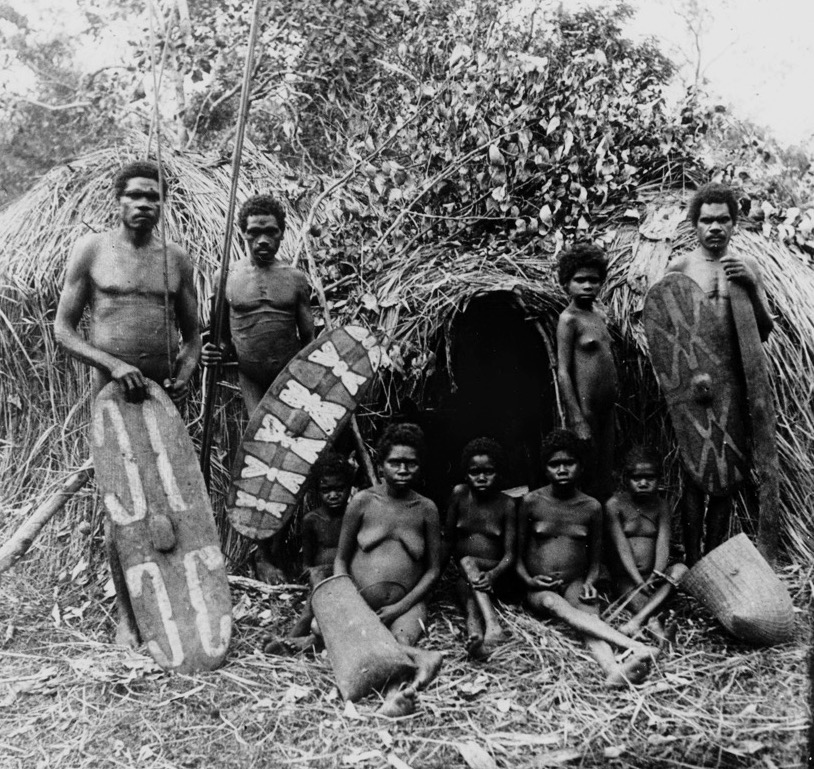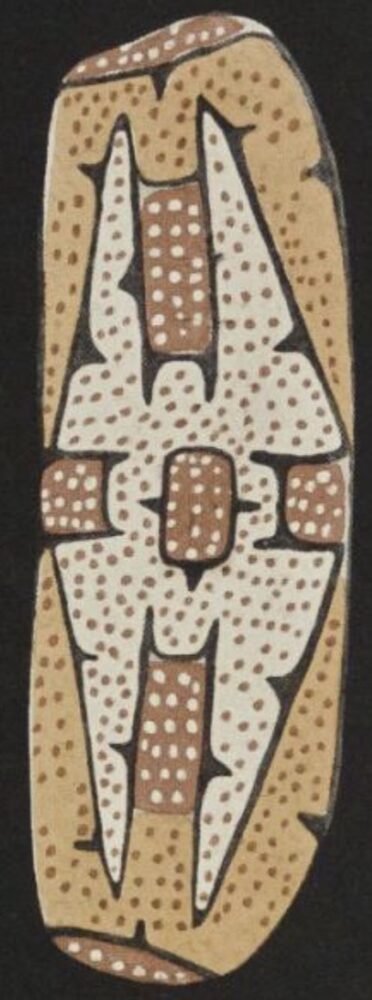Rock Art 2: !Shields
Just south of Townsville there is abundant evidence of Aboriginal occupation in the rock art scattered over the hillsides. This is painted in a wide range of forms, but one of the most frequent images is of a closed border of highly variable form:
described variously as ‘oblong’, ‘true oval’, ‘kidney-like’, ‘crescent’ and even ‘banana-shaped.1
This border encloses a rich variety of designs, frequently with distinctive graphic elements of dots, dashes and cross hatching and often with a central ‘locus’. These various elements combine to produce an image that seems to be unique to this part of Australia. For instance, a close examination of Graham Walsh’s compendium of rock painting in Australia fails to find anything that approximates to this design. ‘They appear exclusive to the former lands of Wulguru people, where they represent a distinctive regional style‘.2
Ever since the first photographs of this rock art were taken in the 1940’s, there has been a strong inclination to interpret the images as being illustrations of rainforest shields:
In Mt Elliot National Park, Townsville, the main subject is the large shield bearing various designs typical of the district.3
Rainforest shields were cut from the buttresses of large fig trees. Fig wood is very light, almost like balsa, which would have made cutting easier and the weight of the often very large shields, up to one metre long, would have been proportionately lighter. The angle of the buttress also explains the often ‘kidney’ shape of the shield:
A curved incision is made in the flange both above and below, and the spur next chipped about halfway through on either side along the lines required and the piece then hammered or pushed out. Such shields are therefore not exactly oval, their shape on one edge depending upon the greater or less concavity of the flange. After this piece has been removed it is chipped away on both surfaces except at the centres, which remain. To the central boss on the front of the shield nothing more is done for the present, though it may subsequently be shaved down a little; into the projection at its future back, however, two longitudinal holes are chipped, these being united below by hot cinders, together constitute a handle at the end of the process.4
Buttress showing the origin of shields ‘curved’ shape 1890’s photograph from Cardwell, showing shield design symmetry SLQ Shield designs drawn by WE Roth c1908
The shape of the shield as described above and the ‘central boss’ are often found in the rock art of the region and this has been taken as evidence that the images are illustrative. The literature continued to extol this view, that ‘many examples…bear designs resembling those on surviving rainforest shields. Oval or kidney shaped, they are decorated in a distinctive and sometimes very intricate pattern’.5 But at the same time a professional convention was introduced which replaced ‘shield’ with ‘!shield’ to indicate that whilst it might look like a shield it might not in fact be one.6
And this was because despite the stated similarities it was proving difficult to match the rock art with the designs on extant rainforest shields.
There is, therefore, considerable evidence to suggest that these shields may have influenced the appearance and design of their possible rock painting counterparts. There is certainly a strong resemblance in shape between the two, and there is some similarity in general design. Most also feature a central boss, but so far, no design on a surviving shield has been found to be identical to a painted representation.7
There is very little evidence of the meaning or otherwise to be found in the designs on rainforest shields. The Norwegian ethnographer, Carl Lumholtz, whilst researching in the Cardwell ranges in the 1880’s, was less than scientific about the shields he witnessed being made when he concluded:
The front is painted in a grotesque and effective manner, with red, white and yellow earth colours, and is divided into fields, which wonderfully enough, differ in each man’s shield, and thus constitute his coat of arms.8
An observation remarkably similar to that of the rigorous chronicler of Aboriginal culture, W E Roth:
In the designs of the patterns so depicted there is no meaning or interpretation, and on this subject very careful enquiries have been made, both by myself and on my behalf throughout the district; there may be some three or four typical styles, but, as a rule, one man copies another’s, the copy being either a travesty or an improvement, according to the light in which it is regarded.9
The only detailed information we have about the designs on rainforest shields comes from Ursula McConnel, who researched the making of shields at the Yarrabah Mission south of Cairns in the 1930’s. Her observations come with the proviso that the information was received from adults who had not received an orthodox initiation, and who ‘regret that they only half remember ’.10
She found that the traditional custodians, the Kúng’gá:ndyi, lived in a rich spiritual world in which all plants, animals and landscape features were imbued with búlerú – the spirit of a totemic ancestor. And the shields, swords, paddles and other implements of manufacture were adorned with designs, that whilst being quite simple, reflected a deeper significance:
Ability to use a shield was one of the prerequisites of candidature for initiation into manhood. A boy on receiving his first “mark” was given a shield “to see if he could handle it” satisfactorily. If so, the “big day” of his final initiation was prepared for, and on this day he received his final “marks” and a shield of his own. After this he was a “wulgun,” i.e., a man. It was then that he “thinks what he is going to put on his shield.”
Shield illustration from McConnel representing the ‘scratches’ and subsequent ‘drops of blood’ obtained for use in ceremonials.
Shield illustration from McConnel representing a ‘Scorpion’.
At this psychological moment his father gave him a new name and “put him along some story,” i.e., identified him with some one búlerú. One rather suspects that, fresh from these stirring experiences, the designs that a man “thinks he will put on his shield” were inspired by a sense of the nearness and protective power of the búlerú guardian from whom the candidate had received his name, and on whose protection, he would certainly have counted in a fight.
Thus, it seems likely that the inspiration of the artist’s choice of design on the shields and other objects was originally drawn not merely from an intimacy with the “common” objects of every-day life but from a belief in the búlerú. who were responsible for the creation of these objects in the beginning and who impregnated them with their spirit, thus making them amenable to human needs.
To aid him in his art the Kúng’gá:ndyi brings an artistic appreciation of form and colour, a delightful sense of humour, a joy in the good things of life, and, above all, an intimate knowledge of nature.11
The painted designs on the shields that McConnel illustrates as well as other examples clearly show graphically simplified forms which might be difficult to interpret without the context that she provides. But most importantly it is clear that the designs on rainforest shields were almost always entirely symmetrical – that is virtually identical when divided by a vertical or horizontal axis.
In this sense they bear almost no resemblance to the rock art paintings found at Clevedon and other sites south of Townsville, and I suggest that their meaning should be sought elsewhere.
Part 3 coming shortly………
1 Hatte L Boring Coastal Stuff? Rock Images of the Townsville District, North Queensland. 1980 p. 71
2 Walsh G Australia’s Greatest Rock Art 1988
3 F D McCarthy Australian Aboriginal Rock Art. 1958 p. 43 Australian Museum, Sydney
4 W E Roth North Queensland Ethnography Bulletin No. 13 1909 p. 204
5 H Brayshaw Well Beaten Paths p. 125
6 Clegg, J 1981 Notes towards Mathesis Art (As listed in Brayshaw 1990 p. 319)
7 Hatte (1980) p. 72
8 Lumholtz C 1890 Among Cannibals: an account of four years travels in Australia and of camp life with the Aborigines of Queensland. P. 120-121
9 Roth (1909)
10 McConnel U H Inspiration and design in Aboriginal Art. Art in Australia, May 15th 1935 pps. 49-68.
11 McConnel (1935) p. 56.




